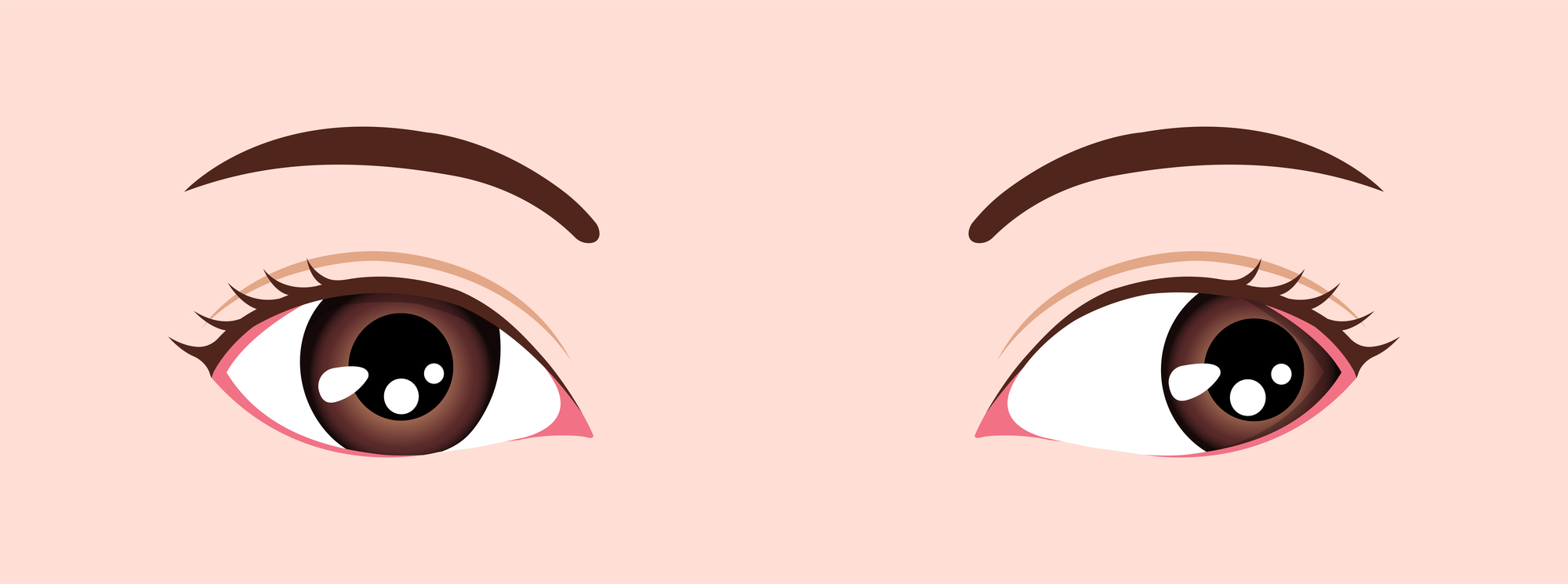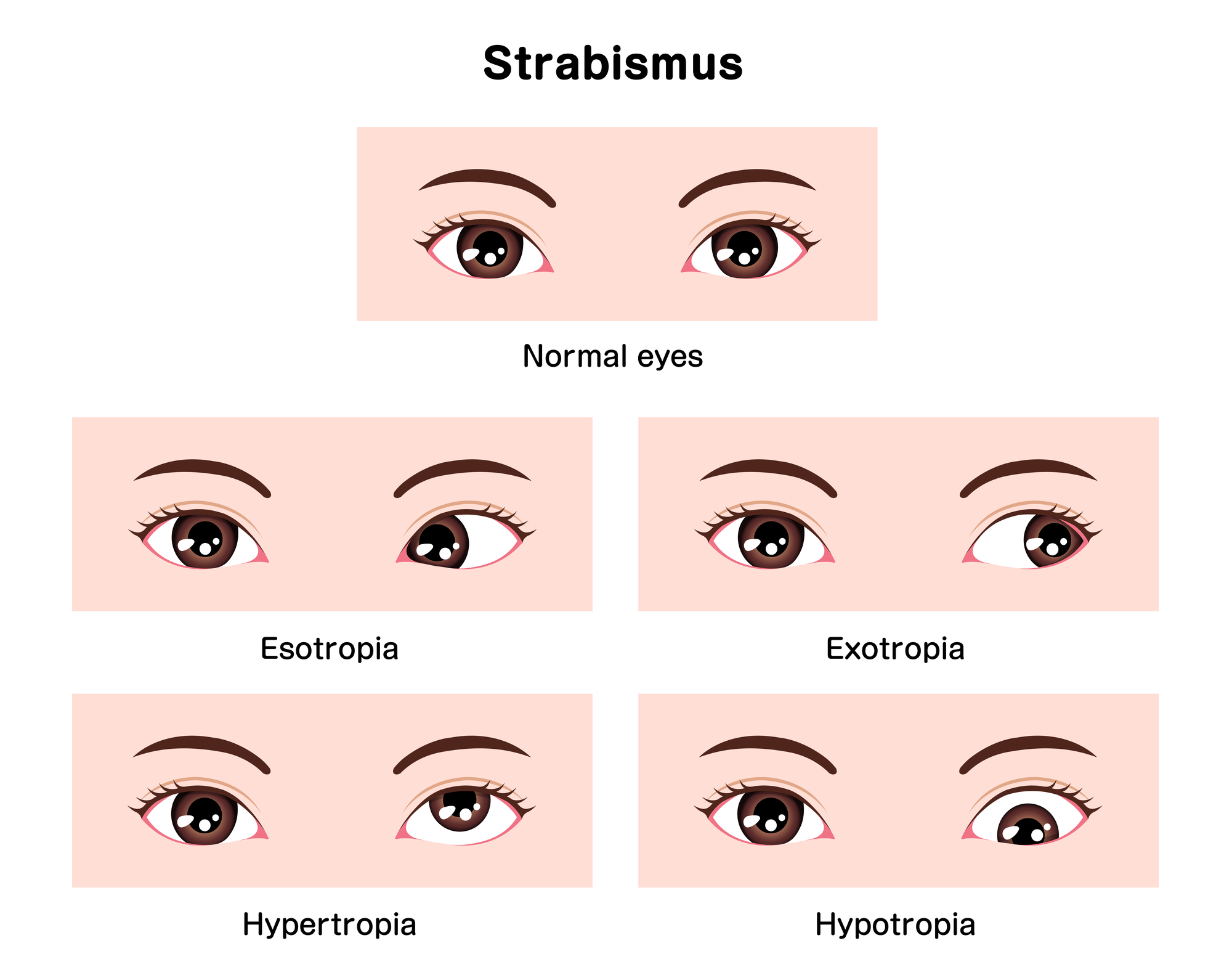Updated on October 9, 2024
What Is Strabismus? (Crossed Eyes)


Vision Center is funded by our readers. We may earn commissions if you purchase something via one of our links.
Strabismus, also called tropia or crossed eyes, is a condition that causes eye misalignment. The eyes point in different directions and don’t line up.

In some cases of crossed eyes, one eye looks straight out while the other turns in or out, up or down. In other cases, both eyes turn in or out, up or down.
With normal vision, both eyes look in the same direction. The brain combines the views from both eyes into a single image with depth perception.
All six eye muscles must move together to focus on an image. With strabismus, they don’t. Because the brain needs both eyes to see correctly, strabismus takes a toll on vision.
What are the Potential Risks of Strabismus?
Untreated strabismus can cause more severe vision problems. For example, it can cause a lazy eye (amblyopia).
Strabismus can also cause health issues related to poor vision. This includes headaches or injury from difficulty seeing.
What are the Symptoms of Strabismus?
Some people with strabismus may not experience any symptoms. However, others experience all or some of the following:2
- Eye position changes (upward or downward turning)
- Blurry vision
- Difficulty seeing close-up objects
- Difficulty seeing far-away objects
- Trouble seeing visual images at any distance
- Double vision
- Headaches
- Squinting to see
- Eyestrain
- Using just one eye to see
- Tilting or turning the head to see
- Struggling to control eye movement
- Sensitivity to bright sunlight in the misaligned eye
- Poor vision development in infancy
What Causes Strabismus?
Here are a few causes of strabismus in adults:1,2
- Medical conditions like diabetes or thyroid disease
- Brain tumors
- Stroke
- Trauma that affects the head or damages the eyes
- Eye surgery
- Botulism
- Graves disease
- Guillain-Barre syndrome
- Family history
- Eye disease
Disorders that Can Cause Strabismus in Children
These conditions encompass many disorders that can result in strabismus in children:2,3
- Cerebral palsy
- Down syndrome
- Congenital rubella
- Prader-Willi syndrome (PWS)
- Incontinentia pigmenti syndrome (causes skin, hair, eye, teeth, and central nervous system (CNS) abnormalities)
- Apert syndrome (causes skull, hand, feet, and face abnormalities)
- Retinopathy of prematurity (ROP)
- Retinoblastoma (retina cancer)
- Trisomy 18 (Edward’s syndrome)
- Hemangioma close to the eye
- Noonan syndrome
What are the Types of Strabismus?

The four main types of strabismus are:4
- Esotropia. The eyes turn inward
- Exotropia. The eyes turn outward
- Hypertropia. The eyes turn upward
- Hypotropia. The eyes turn downward
What are the Common Forms of Strabismus?
The two most common forms of strabismus are:5
- Accommodative esotropia. It tends to happen when you don’t treat farsightedness, but it may also be genetic.
- Intermittent exotropia. It occurs when one eye fixates on an object while the other points outward. The eye turn is only present sometimes.
Strabismus affects approximately 3% of children.6 Such untreated condition in 50% of children may experience visual loss due to lazy eye (amblyopia).
A lazy eye involves weak muscles. Therefore, the brain uses the stronger eye more, worsening the weaker one over time.
How Do You Diagnose Strabismus?
Your doctor will perform an eye exam to diagnose you or your child with strabismus. During the test, they will assess visual acuity.
Visual acuity includes depth perception and how well you can see letters or numbers at different distances. Your doctor will also perform a retinal and neurological exam.4
What are the Treatment Options for Strabismus?
You can't prevent strabismus. However, early treatment can help prevent further vision problems and improve the condition.
Treatment for strabismus depends on the cause, budget, and your candidacy, among other factors. Here are some treatment options that your doctor may recommend:2,7
- Eyeglasses or contact lenses. They can treat refractive errors that cause strabismus and help if you struggle to see far-away objects, which can cause intermittent exotropia.
- Prism lenses. These special lenses help bend light to reduce how much the eye turns to view things.
- Medications. Certain medications like eye drops and botulinum toxin type A (Botox) can treat strabismus by weakening overactive muscles in the eye.
- Orthoptics. Vision therapy exercises can strengthen certain eye muscles and improve control of eye misalignments.
- Eye muscle surgery. Under general anesthesia, this operation changes eye muscle length or position to align them.
- Eye patches. These tools cover the stronger eye to strengthen the muscles in the weaker one. They also improve eye movement control.
If you have a child, schedule regular eye exams to catch and treat strabismus early as early as six months old. If you're an adult, schedule an appointment with an eye doctor if you notice any changes in your vision.
What is the Outlook for Strabismus?
The outlook for strabismus is positive if you treat it early. Timely medical intervention can improve symptoms like double vision, difficulty understanding depth perception, and vision loss.
When to See a Doctor
You should seek immediate medical attention if you experience any of the following:
- You're experiencing difficulties with clear vision
- Your sight problems worsen despite treatment
- You’re concerned about your child's eyesight, especially if they’re at least three months old and their eyes appear misaligned (even intermittently)4
Doctors diagnose most children who develop strabismus between the ages of 1 and 4 years old. Some develop the condition after age six due to other health conditions.3
Summary
Crossed eyes are a common eye problem that can affect vision. If you or someone you know is struggling with strabismus, talk to an eye doctor.
Your eye doctor will run tests to diagnose any vision issues and treat them accordingly. Leaving strabismus untreated can cause more sight issues later on.
In this article
9 sources cited
Updated on October 9, 2024
Updated on October 9, 2024
About Our Contributors
AnnaMarie, a staff writer for Vision Center, specializes in ophthalmology, optometry, and basic optic procedures, as well as preventative eye care. With a B.A. in Journalism & New Media and minors in Creative Writing and Women, Gender & Sexuality Studies from Gettysburg College, her goal is to enhance readers' understanding of eye health. She covers a wide range of topics, from selecting the right eyeglasses and contacts to managing and preventing eye diseases, and exploring vision correction surgeries.
Dr. Melody Huang is an optometrist and freelance health writer with a passion for educating people about eye health. With her unique blend of clinical expertise and writing skills, Dr. Huang seeks to guide individuals towards healthier and happier lives. Her interests extend to Eastern medicine and integrative healthcare approaches. Outside of work, she enjoys exploring new skincare products, experimenting with food recipes, and spending time with her adopted cats.

